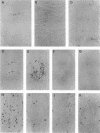Abstract
The CVS strain of fixed rabies virus causes acute, fatal encephalomyelitis in young adult ICR mice. Variant RV194-2, which was selected from CVS virus in cell culture with a neutralizing antiglycoprotein monoclonal antibody, has a single amino acid change in the glycoprotein. The infections caused by CVS virus and RV194-2 virus were compared in mice for 14 days postinoculation of 5 x 10(7) PFU into the right masseter muscle. All CVS virus-infected mice died (mean time to death, 7.9 days), compared with a mortality rate of 8.5% for RV194-2 virus-infected mice. RV194-2 virus spread to the ipsilateral trigeminal ganglion during the first 2 days postinoculation, and both viruses spread to the ipsilateral motor nucleus of the trigeminal nerve in the pons. Both viruses spread centrifugally and caused infection of bilateral trigeminal ganglia on day 3. The viruses spread throughout the central nervous system (CNS) at similar rates, but CVS virus infected many more neurons than did RV194-2 virus. Rabies virus antigen was observed in only occasional CNS neurons after day 6 of RV194-2 virus infection. By this time, CVS virus had caused severe widespread infection. In this model, virulence depends on improved efficiency of viral spread between CNS neurons rather than the rate of spread or topographical distribution of the infection.
Full text
PDF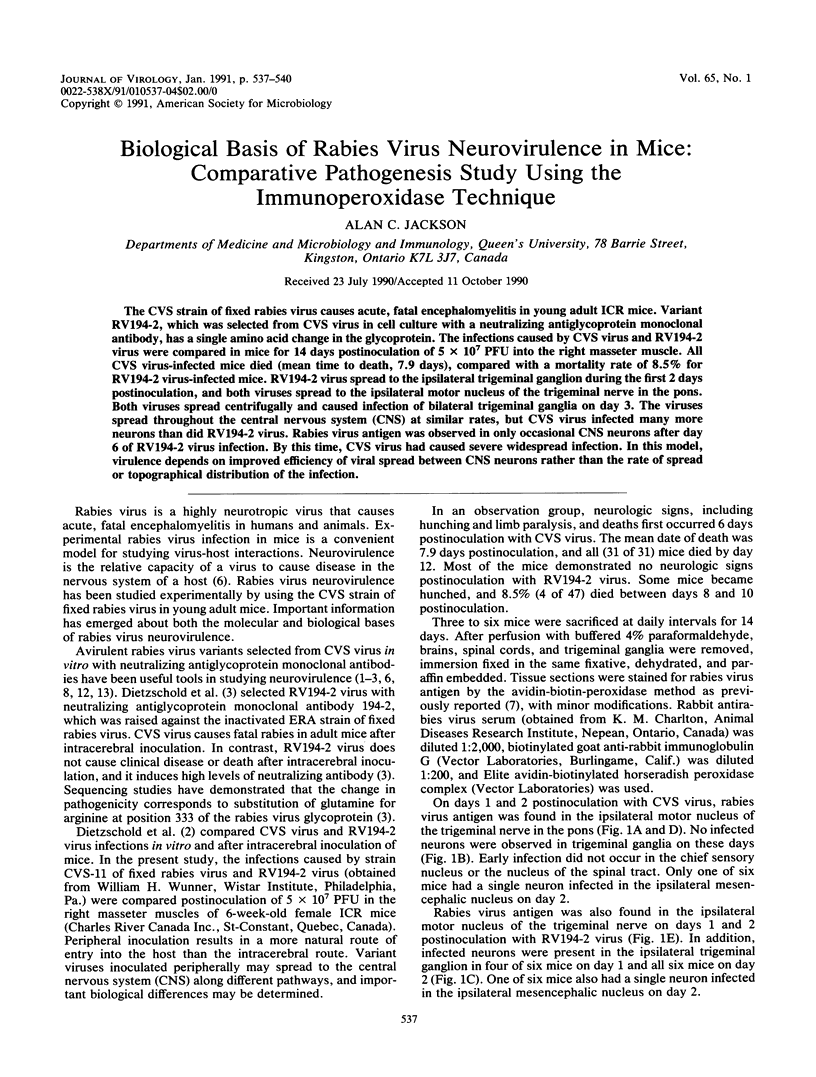
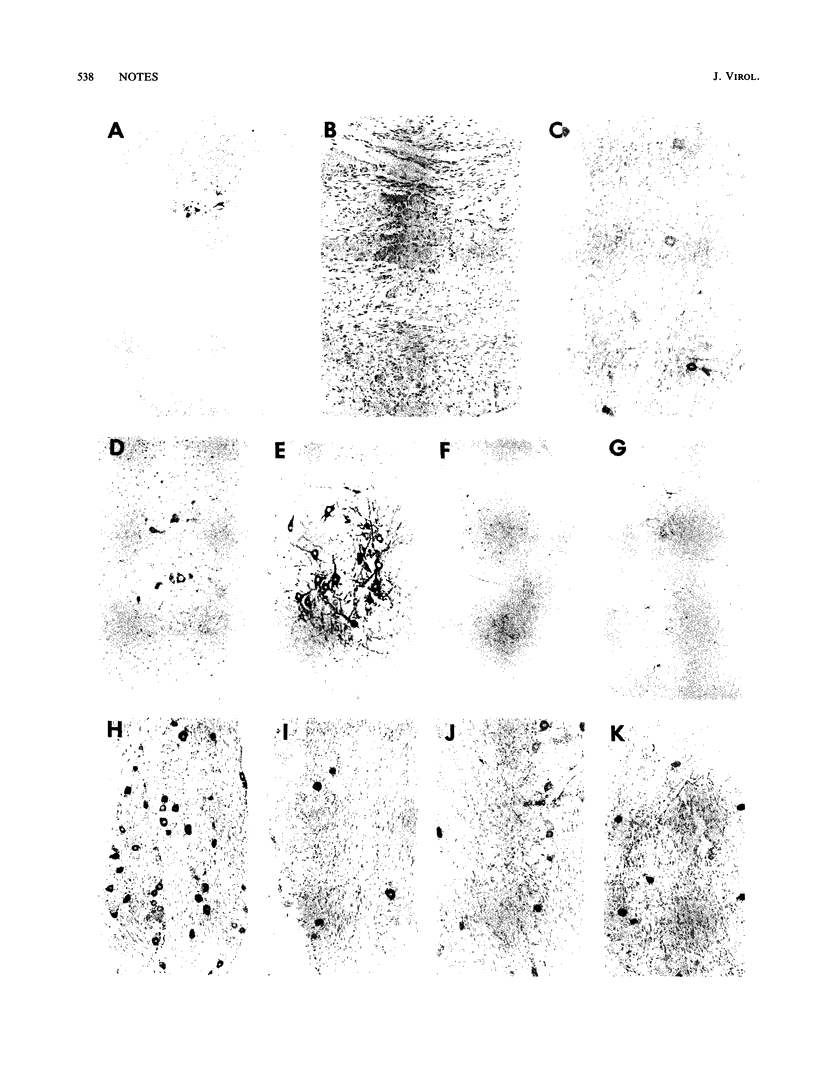
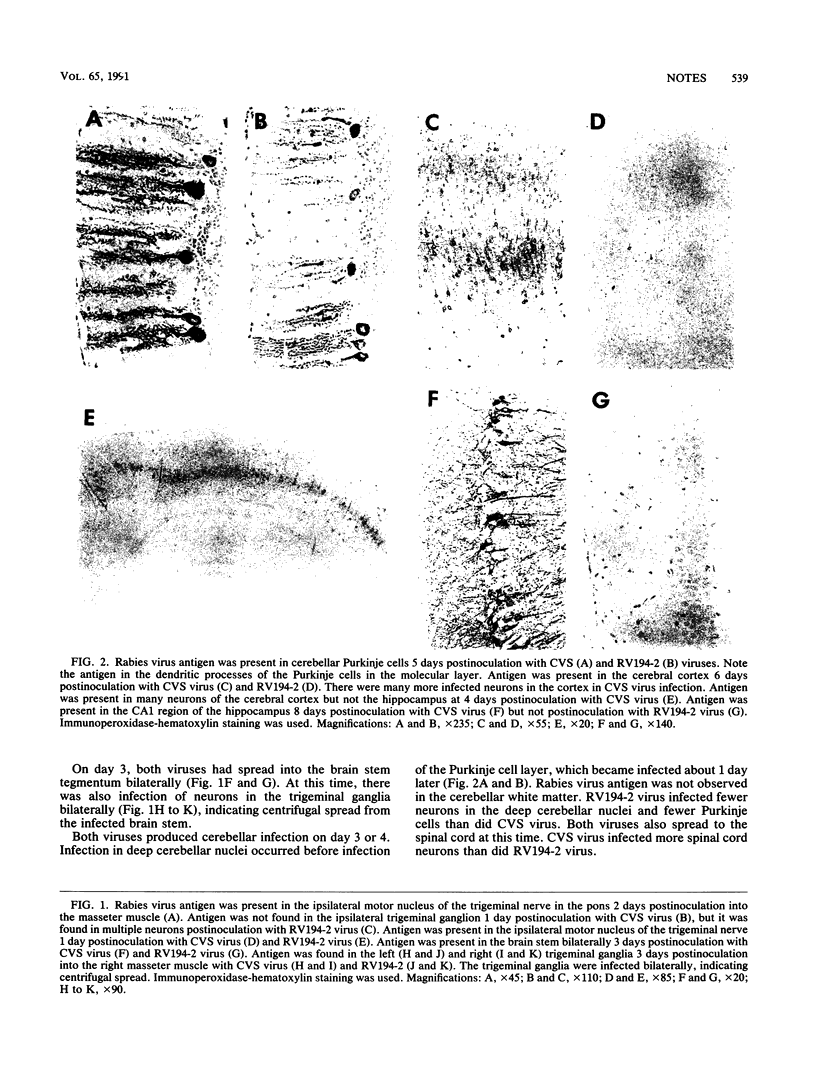
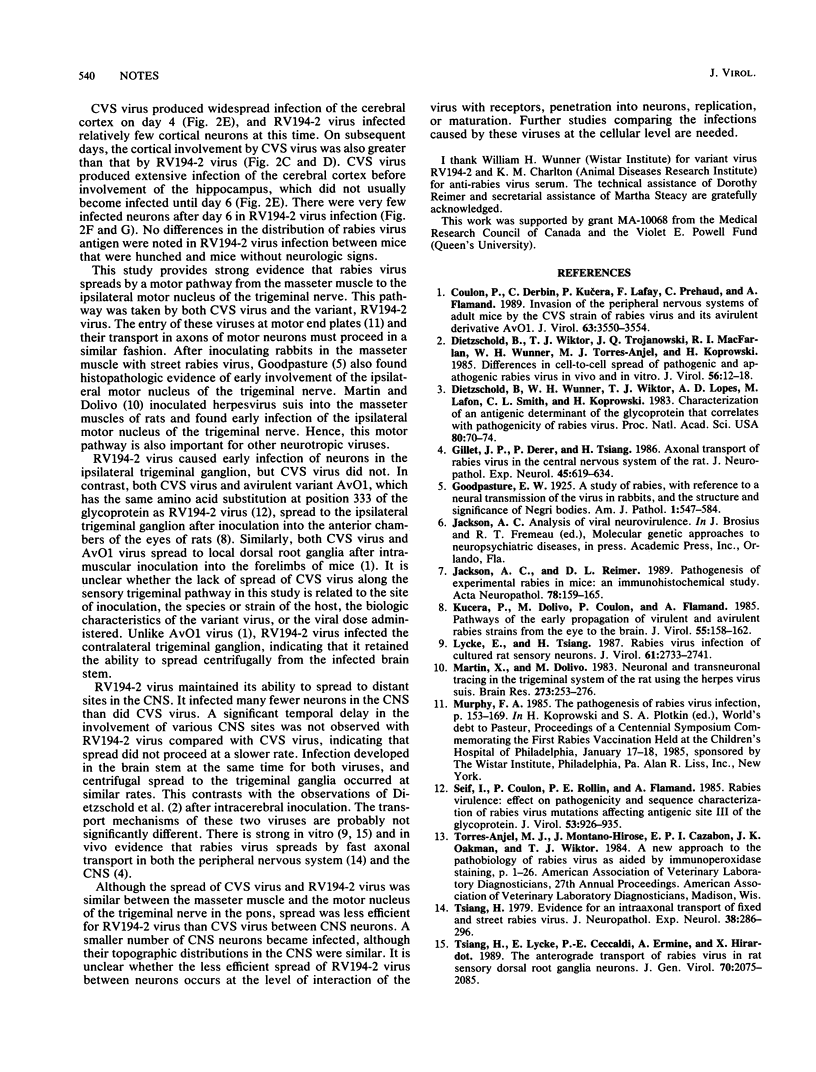
Images in this article
Selected References
These references are in PubMed. This may not be the complete list of references from this article.
- Coulon P., Derbin C., Kucera P., Lafay F., Prehaud C., Flamand A. Invasion of the peripheral nervous systems of adult mice by the CVS strain of rabies virus and its avirulent derivative AvO1. J Virol. 1989 Aug;63(8):3550–3554. doi: 10.1128/jvi.63.8.3550-3554.1989. [DOI] [PMC free article] [PubMed] [Google Scholar]
- Dietzschold B., Wiktor T. J., Trojanowski J. Q., Macfarlan R. I., Wunner W. H., Torres-Anjel M. J., Koprowski H. Differences in cell-to-cell spread of pathogenic and apathogenic rabies virus in vivo and in vitro. J Virol. 1985 Oct;56(1):12–18. doi: 10.1128/jvi.56.1.12-18.1985. [DOI] [PMC free article] [PubMed] [Google Scholar]
- Dietzschold B., Wunner W. H., Wiktor T. J., Lopes A. D., Lafon M., Smith C. L., Koprowski H. Characterization of an antigenic determinant of the glycoprotein that correlates with pathogenicity of rabies virus. Proc Natl Acad Sci U S A. 1983 Jan;80(1):70–74. doi: 10.1073/pnas.80.1.70. [DOI] [PMC free article] [PubMed] [Google Scholar]
- Gillet J. P., Derer P., Tsiang H. Axonal transport of rabies virus in the central nervous system of the rat. J Neuropathol Exp Neurol. 1986 Nov;45(6):619–634. doi: 10.1097/00005072-198611000-00002. [DOI] [PubMed] [Google Scholar]
- Goodpasture E. W. A Study of Rabies, with Reference to a Neural Transmission of the Virus in Rabbits, and the Structure and Significance of Negri Bodies. Am J Pathol. 1925 Nov;1(6):547–582.3. [PMC free article] [PubMed] [Google Scholar]
- Jackson A. C., Reimer D. L. Pathogenesis of experimental rabies in mice: an immunohistochemical study. Acta Neuropathol. 1989;78(2):159–165. doi: 10.1007/BF00688204. [DOI] [PubMed] [Google Scholar]
- Kucera P., Dolivo M., Coulon P., Flamand A. Pathways of the early propagation of virulent and avirulent rabies strains from the eye to the brain. J Virol. 1985 Jul;55(1):158–162. doi: 10.1128/jvi.55.1.158-162.1985. [DOI] [PMC free article] [PubMed] [Google Scholar]
- Lycke E., Tsiang H. Rabies virus infection of cultured rat sensory neurons. J Virol. 1987 Sep;61(9):2733–2741. doi: 10.1128/jvi.61.9.2733-2741.1987. [DOI] [PMC free article] [PubMed] [Google Scholar]
- Martin X., Dolivo M. Neuronal and transneuronal tracing in the trigeminal system of the rat using the herpes virus suis. Brain Res. 1983 Aug 29;273(2):253–276. doi: 10.1016/0006-8993(83)90850-8. [DOI] [PubMed] [Google Scholar]
- Seif I., Coulon P., Rollin P. E., Flamand A. Rabies virulence: effect on pathogenicity and sequence characterization of rabies virus mutations affecting antigenic site III of the glycoprotein. J Virol. 1985 Mar;53(3):926–934. doi: 10.1128/jvi.53.3.926-934.1985. [DOI] [PMC free article] [PubMed] [Google Scholar]
- Tsiang H. Evidence for an intraaxonal transport of fixed and street rabies virus. J Neuropathol Exp Neurol. 1979 May;38(3):286–299. doi: 10.1097/00005072-197905000-00008. [DOI] [PubMed] [Google Scholar]
- Tsiang H., Lycke E., Ceccaldi P. E., Ermine A., Hirardot X. The anterograde transport of rabies virus in rat sensory dorsal root ganglia neurons. J Gen Virol. 1989 Aug;70(Pt 8):2075–2085. doi: 10.1099/0022-1317-70-8-2075. [DOI] [PubMed] [Google Scholar]



